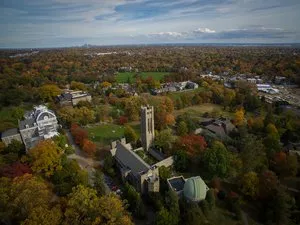Mellon Tri-College Creative Residencies Program Brings Boundary-Breaking Artists to Swarthmore

This year saw the inception and blossoming of the new Mellon Tri-College Creative Residencies program, funded by the Andrew W. Mellon Foundation and coordinated by Thomas Warren Bonner. The program will run for a total of three years and is overseen by Haverford College's John B. Hurford '60 Center for the Arts and Humanities (HCAH). Following a 2007 planning grant to the HCAH from the Andrew W. Mellon Foundation, Haverford began to experiment with creative artist residencies. In 2011, another greatly expanded grant was issued to form the tri-college program that exists today.
Bonner believes that integrating the arts into all academic divisions is incredibly important.
"I have a long background in the arts," he says, "and a fierce belief in the notion that engagement with the arts makes for better students, professionals, and citizens in general. This program is literally a proving ground for the types of interdisciplinary collaborations that could very well [be] the future of arts education in our country."
In one year alone, the program sponsored more than a dozen residencies of a diverse group of artists with over $140,000 in funding, organizing over 80 public and private events across the tri-co and bringing students and faculty together with multi-disciplinary approaches.
Bonner explains that the term "artists" not only refers to "practitioners of traditional media [...] but also a spectrum of creators, including innovative practitioners of scientific narrative and imaging, creative non-fiction writers, performance artists, illustrators, architects, sonic fabulists, environmental bricoleurs, explorers of virtual media and spaces, 'outsider' image-makers, multimedia curators, and others working at the frontiers of what we think of as 'art.'"
So far, the Mellon Tri-College Creative Residencies program has introduced a plethora of people and ideas to Swarthmore that cross boundaries - whether between math and dance, sight and sound, photography and activism, or the United States and Haiti.
One residency, called "What Can a Body Do?," featured artists who explore themes of disability in their work. Although an exhibition of the same name was based in Haverford's Cantor Fitzgerald Gallery, resident artist Christine Sun Kim, who is deaf, gave a presentation at Swarthmore in late October, organized by Professor of Linguistics Donna Jo Napoli and interpreted from American Sign Language to spoken English for the audience. Napoli invited all of her linguistics classes, and also spread the word to psychology and cognitive science students and faculty. Sun Kim, a New York City-based performance artist, practices "seismic calligraphy" or "sound translation" in order to visually and physically capture sounds. Using everything from a drum head to subwoofers, she records the splatters or lines of paint that result from different patterns or frequencies of sound.
Artist and environmental activist J. Henry Fair displayed his photography in an exhibition, "Extraction and the American Dream," at McCabe Library in late January. He also gave a public lecture and Q&A session at the opening of the exhibition, in which he discussed the dangerous destruction that rampant human consumption can cause. His work beautifully displays sites where nature has been devastated, in startling and violent ways. Fair travels to these sites of disaster, from the BP Gulf of Mexico oil spill to mineral extraction facilities, and often takes photographs from planes to create expansive aerial views.
Fair was chosen as a resident artist due in part to a class project on water rights done by a 2010 Environmental Studies capstone seminar. The seminar was taught that year by Carol Nackenoff, the Richter Professor of Political Science. When her students discovered Fair's photographs and negotiated permission to use them on the website they were creating about hydrofracking, Nackenoff was struck by his work. She later wrote a proposal, which was accepted, to bring Fair to campus through the Mellon program. During his residency, Fair met, fittingly, with Swarthmore political science students.
In April, Emmy-award winning filmmaker Louis Massiah visited Swarthmore to give a lecture, "The Method is the Message: Approaches to Documentary by an African-American Filmmaker." Massiah is the founder and executive director of the Scribe Video Center and served as the 2010-2011 Lang Professor for Issues of Social Chance at Swarthmore. He is also known for the film project he worked on, "Haytian Stories," which began as a collaborative effort between African-American and Haitian-American filmmakers and is an attempt to explore 200 years of history between the United States and Haiti.
In addition to his public appearance at Swarthmore, Massiah also worked with students in Professor Carina Yervasi's Francophone African Cinemas class on the development of their own film. This collaboration is an example of another one of the strengths of the Creative Residencies program: it fosters creativity and flexibility, allowing professors to rework traditional curricula in order to keep courses dynamic and relevant.



